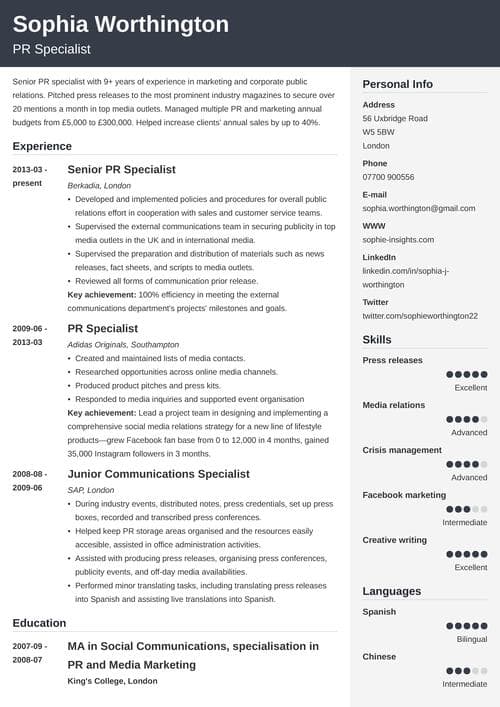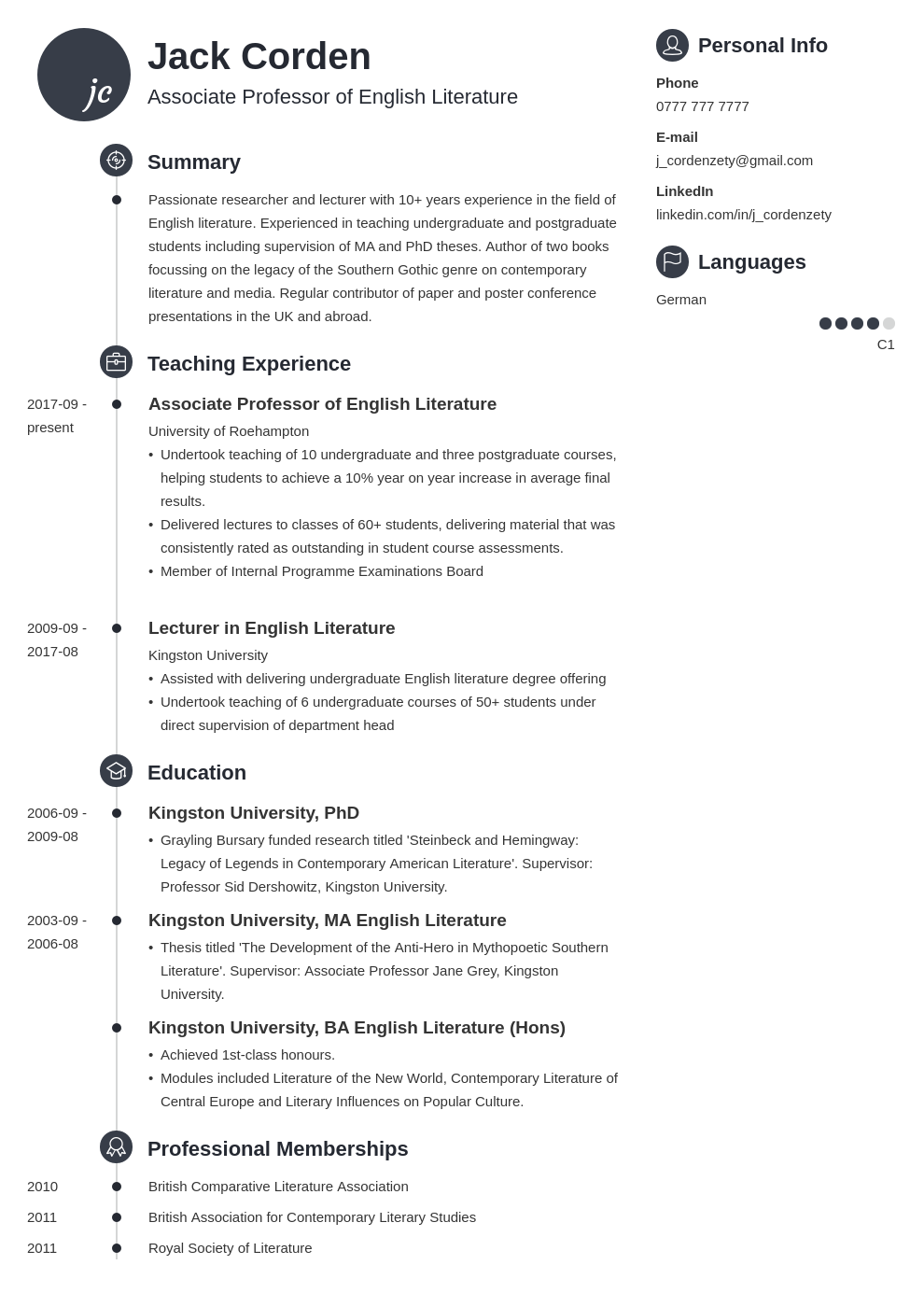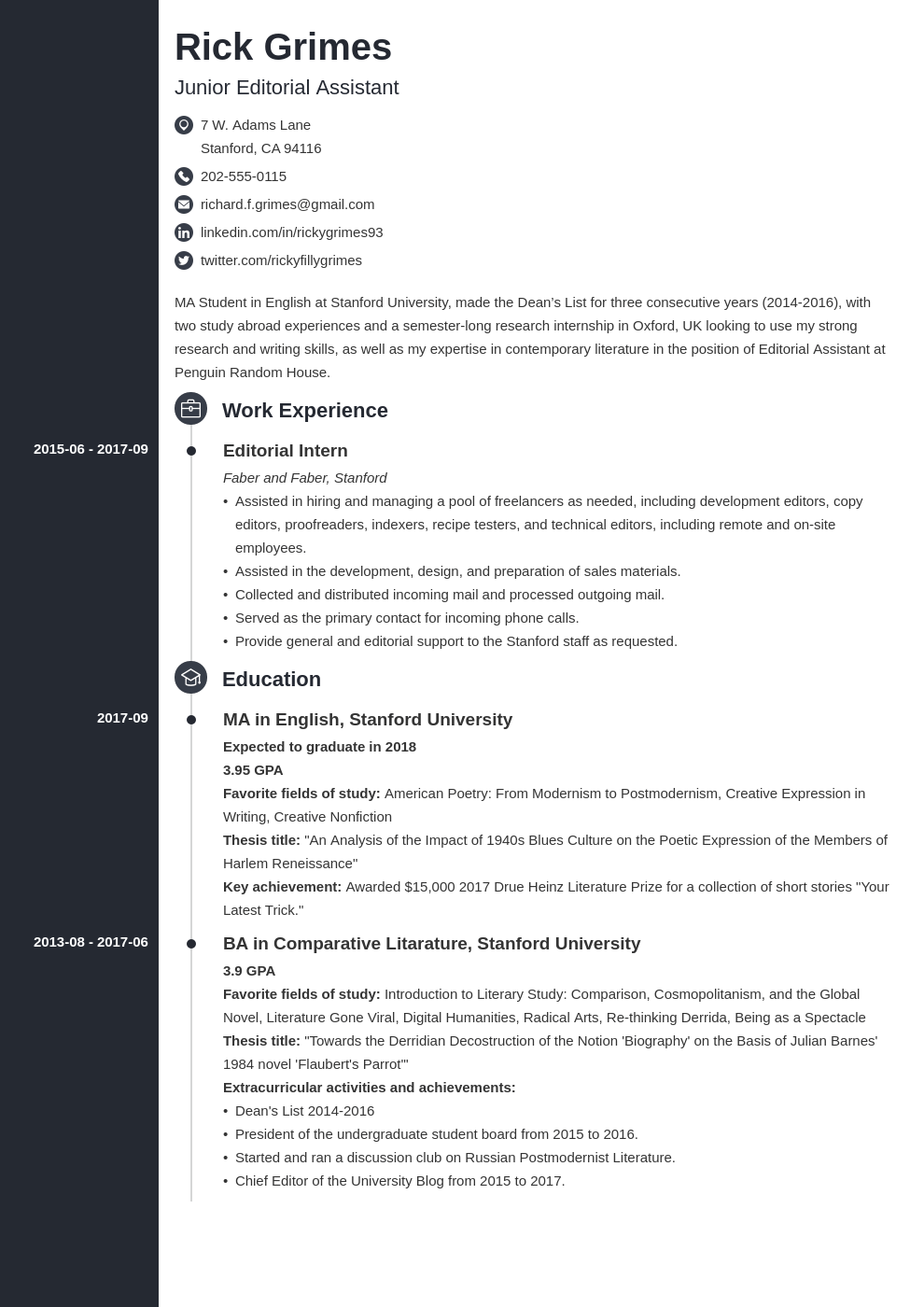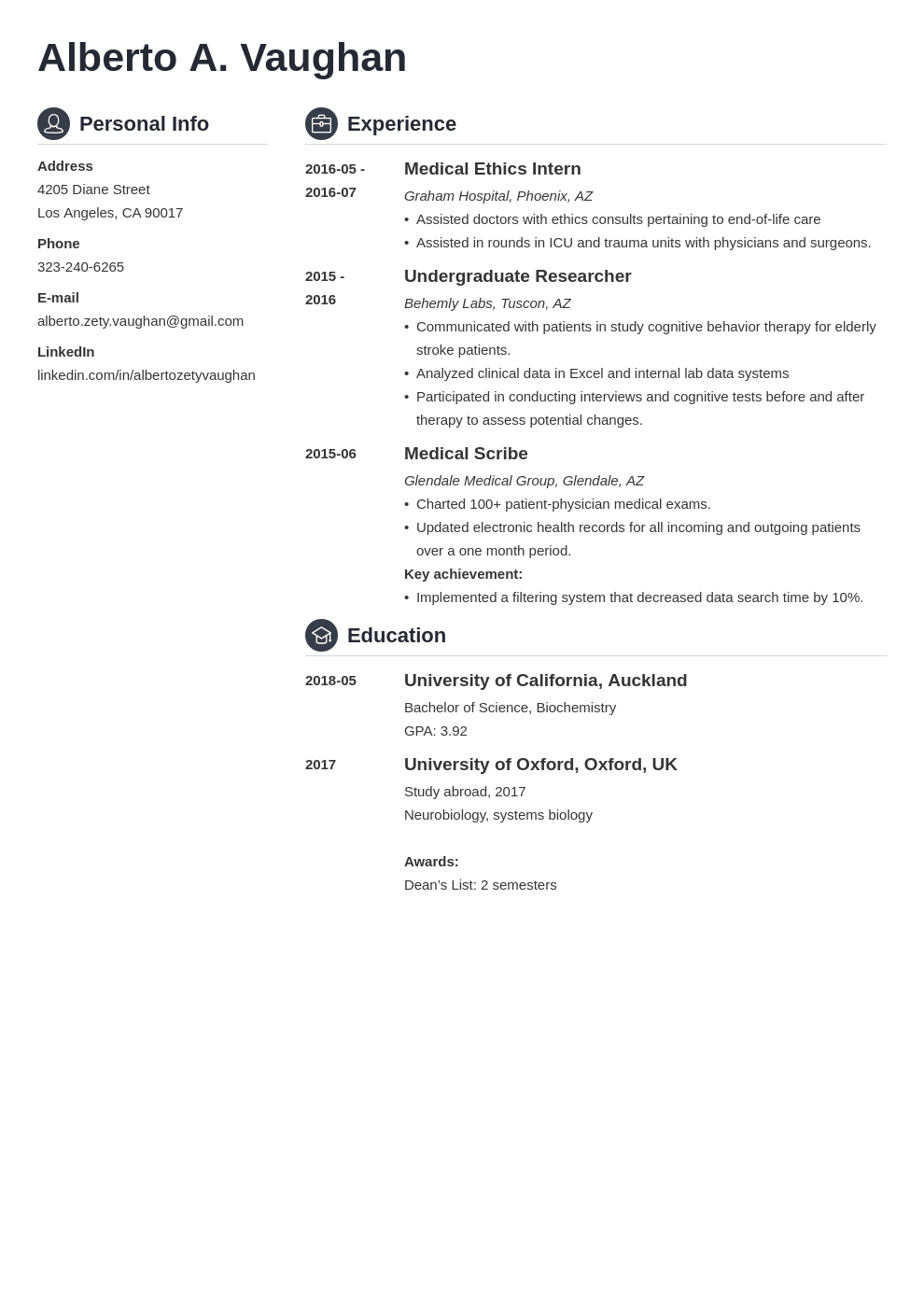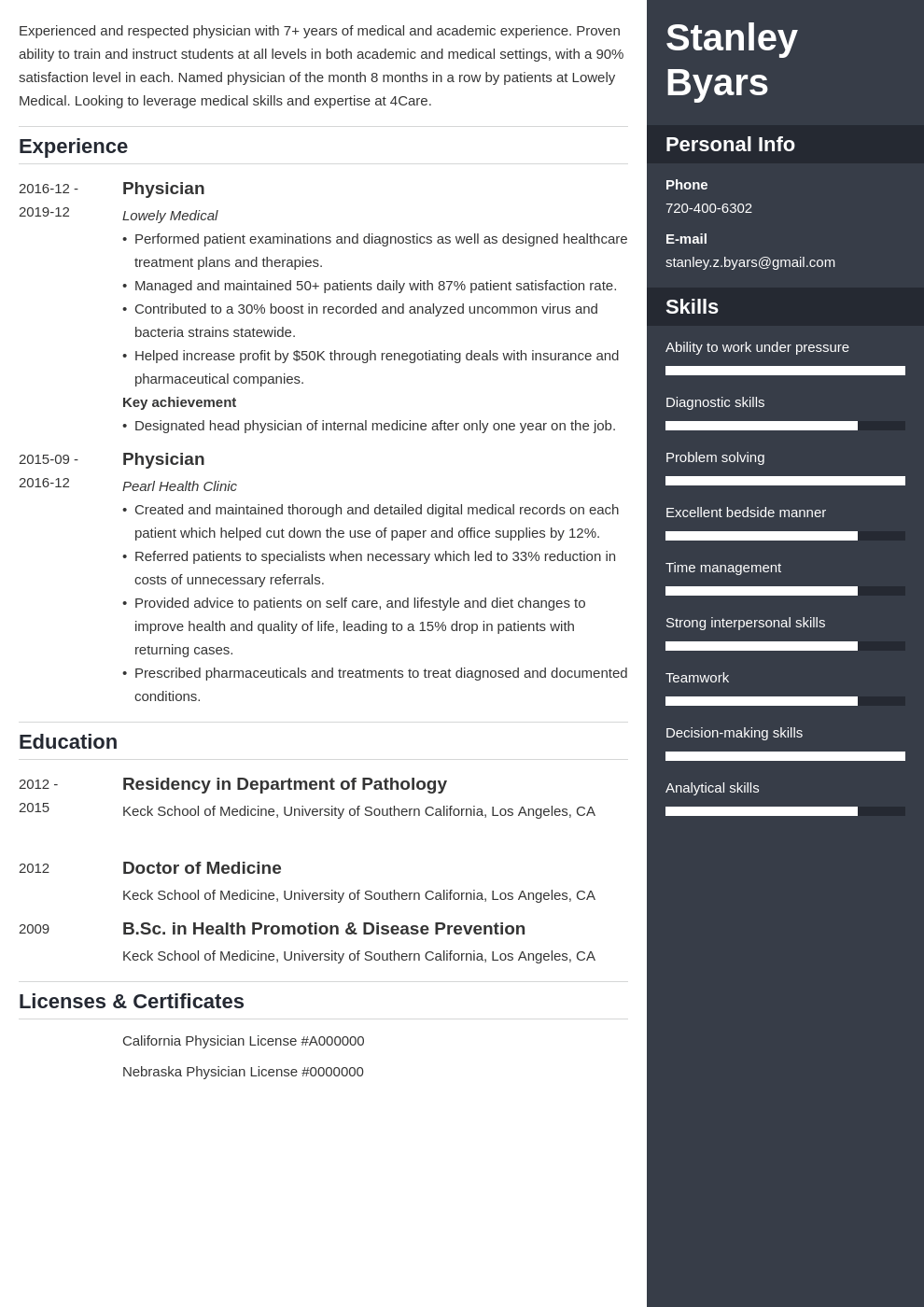Writing a CV might seem tricky at first, but it’s easier than you think.
Whether you're an academic or simply a job seeker looking for your next role, having a clear and well-organized CV is important. It helps you share your accomplishments, projects, and skills in a way that stands out.
In this guide, we’ll show you how to put your CV together step by step and offer professional templates to help you get started. In this guide, you’ll learn:
- What to include in each section
- Tips for creating a CV
- How to make a great impression
We’ll make putting together your CV a simple process. Let’s get started!
Want to save time and have your CV ready in five minutes? Try our CV builder. It’s fast and easy to use. Plus, you’ll get ready-made content to add with one click. See 20+ CV templates and create your CV here.
Sample CV made with our builder—See more CV samples here.
What Is a CV?
A CV, short for curriculum vitae, is a detailed document that outlines your professional and academic history, including your work experience, education, skills, publications, and achievements.
In the U.S., Canada, and Australia, CVs are mainly used when applying for jobs in academia, research, and medicine, where a full record of your qualifications is important.
In most other parts of the world—including Europe, Asia, Africa, and the Middle East—a CV is the standard document for all job applications. Employers in these regions expect a CV to include personal information, a career summary, and a detailed list of qualifications and work history.
What is the difference between a CV and a resume?
A CV and a resume differ in a few ways:
- Length: Resumes are a one or two-page snapshot of your qualifications. In contrast, a CV can run several pages long.
- Purpose: In the U.S., resumes are the standard document to apply for jobs, while a CV is mainly used in academia, research, and medicine.
- Content: Resumes should be tailored to every job position, showing only the most relevant credentials. CVs include your complete work experience, academic background, skills, and other qualifications. This detailed view makes them mostly static.
How to Write a CV
Now that you know what a CV is, it’s time to build one!
Don’t worry—you don’t need to be a writing expert to make a great CV. All you need is some time, a little focus, and a clear idea of what you’ve done so far in your career.
Follow these easy steps to learn how to make a CV:
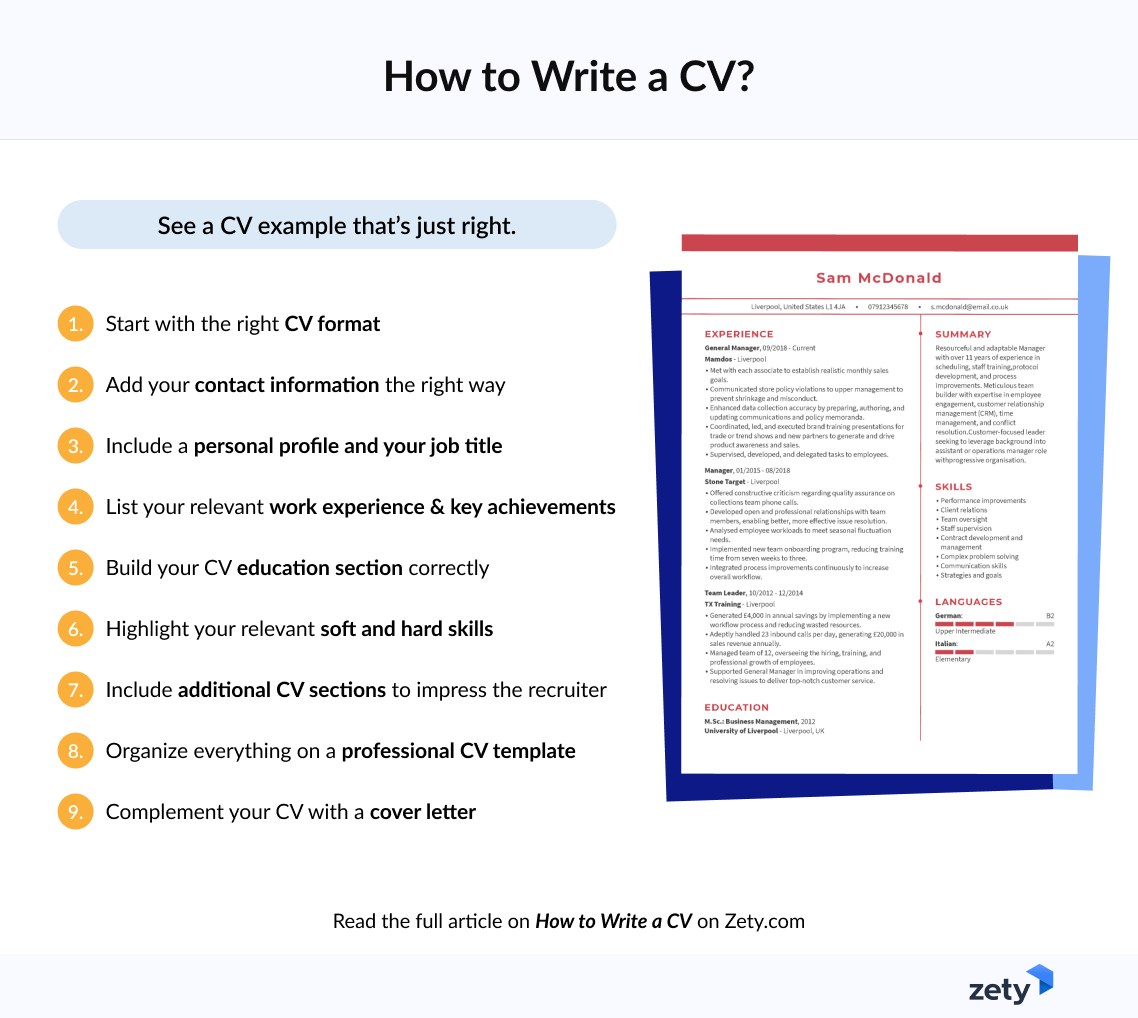
Step 1: Gather your information
The very first step to creating your CV is collecting all your essential career details. Make a list with the following:
- Education credentials: All institutions you attended after high school, along with degrees, honors, awards, and thesis or dissertation titles.
- Work experience: Past job titles, company names, locations, employment dates, responsibilities, and achievements.
- Skills: All your proficiencies, whether hard, soft, or technical.
- Publications and presentations: If you wrote papers or participated in conferences, include them.
- Certifications or licenses: Any specialized training you obtained, with its completion date.
- Professional affiliations: Memberships to industry organizations, if applicable.
- Awards and honors: Any scholarship, grant, or recognition you've earned in your career.
Step 2: Add your contact details
Once you have your professional CV template, you can start adding your contact information. Include the following:
- Full name
- Phone number
- Professional email address
- City, state, or country, and ZIP code
- Network profile and portfolio, if applicable
Step 3: Write your professional summary
An attention-grabbing summary is key to a strong CV. In four sentences or less, highlight your strongest accomplishments and skills. Focus on using this introduction to impress recruiters and get them to read your CV.
See this sample CV summary:
Detail-oriented anthropology researcher with a strong background in ethnographic fieldwork, cultural analysis, and academic writing. Experienced in conducting qualitative and quantitative research across diverse cultural settings, focusing on medical anthropology. Proven ability to manage complex projects, present findings at academic conferences, and publish in peer-reviewed journals. Committed to advancing anthropological knowledge through ethical research practices, interdisciplinary collaboration, and meaningful community engagement.
Step 4: List your work experience
Your CV should list all your past job positions in reverse-chronological order. Include the job title, company or institution name, employment dates, and locations. Write your duties in bullet points.
If you achieved anything special in the workplace, add that too to show what you can do. Use numbers or percentages to prove how you can contribute to the team.
Take a look at this work experience example:
Project Manager
Day Solutions | London, UK
January 2022 - Present
- Successfully reduced project delivery time by 20% by implementing Agile Scrum methodologies.
- Delivered a complex CRM integration project 15% under budget, resulting in $180K in cost savings for the client.
- Oversaw budgets averaging $1.2M and collaborated with vendors, developers, and QA teams throughout project life cycles.
Pro-tip: Use strong action words to make your ideas stand out and show that you are ready to take charge.
Step 5: Create your education section
The education section is a crucial part of your CV, especially if applying to a job in academia. Write the degrees you've earned, starting with the highest one. Include the school's name and graduation date. Add any academic honors, awards, theses, or dissertations as well.
Here's an example:
Master of Arts in Anthropology
University of Texas | Austin, TX
Graduated: May 2025
- Thesis: “Narratives of Resilience: Cultural Memory and Identity Among Displaced Communities in Central America”
- Honors: Dean’s Graduate Honor List, 2023-2024
Bachelor of Arts in Anthropology, Minor in Latin American Studies
Barnard College | New York, NY
Graduated: May 2021
- Honors: Magna Cum Laude
- Senior Capstone Project: “Traditional Healing Practices in Contemporary Urban Settings”
Pro-tip: If you want to take your academic background to the next level, add relevant coursework!
Step 6: Highlight your skills
Make a list including soft, hard, and technical skills to show you're well-rounded. Knowing how to use software and having communication skills can prove to employers that you can do the job and be a team player.
Here are some soft skills to add:
- Leadership
- Analytical thinking
- Problem-solving
- Active listening
- Computer skills
Some examples of hard skills are:
- Project management software
- Budget management
- Risk management
- Scheduling and planning
- Data analysis and reporting
Step 7: Include additional sections
Remember, a CV is a detailed account of your career. Any credential that shows your expertise should be included in your document. You can add:
- Professional memberships
- Industry awards
- Conferences and publications
- Hobbies and interests
- Projects
- Volunteer experience
- Freelance work
Professional CV Templates
Writing a standout CV becomes easier with a tried and tested template. We have many professionally designed CV templates to choose from. Tailor them to your needs with ease.
Academic CV Template
Artist CV Example
Graduate CV Sample
Medical Student CV Template
Physician CV Example
Need more inspiration? Check out our full list of over 600 CV examples to find ideas for your own.
CV Writing and Formatting Tips
Follow these tips to ensure your CV stands out from the competition:
- Keep it neat and clean: Use one professional font like Arial or Times New Roman. Leave space between sections and make your font size 11 or 12 so everything is clear.
- Use headings to stay organized: Break your CV into sections with bold or larger font headings so they stand out.
- Write in bullet points: Use bullet points to list your tasks or accomplishments. Start each point with a strong action word like “organized,” “led,” or “researched.”
- Align everything to the left: Keep your text lined up on the left side of the page. This makes it easier to read and helps your CV look clean and professional.
- Keep margins even: Use 1-inch margins on all sides of the page. This gives your CV some “breathing room” and keeps it from looking too crowded.
- Check spelling and grammar: Read your CV out loud or ask someone to check it. One small mistake can make it look messy or rushed.
- Save and send as a PDF: Always save your CV as a PDF before you send it. That way, the formatting won’t change when someone opens it on their computer.
Key Takeaways
You learned how to create a CV. Now, let's go over some key points:
- CVs are a detailed document showing your entire career. They usually run several pages long.
- Resumes are the standard for applying to U.S.-based jobs, but positions in academia and research require CVs.
- In Europe, Asia, Africa, and other parts of the world, a CV is the standard document for searching for jobs.
- Always include your contact details, professional summary, work experience, education, and skills. Add any other credential that shows your expertise.
- Bullet points, professional fonts, and simple formatting can make your CV stand out.
- Remember to check your spelling and grammar before saving your CV.
About Zety’s Editorial Process
This article has been reviewed by our editorial team to make sure it follows Zety's editorial guidelines. We’re committed to sharing our expertise and giving you trustworthy career advice tailored to your needs. High-quality content is what brings over 40 million readers to our site every year. But we don't stop there. Our team conducts original research to understand the job market better, and we pride ourselves on being quoted by top universities and prime media outlets from around the world.
